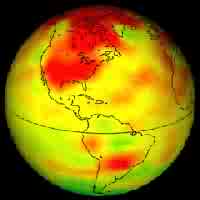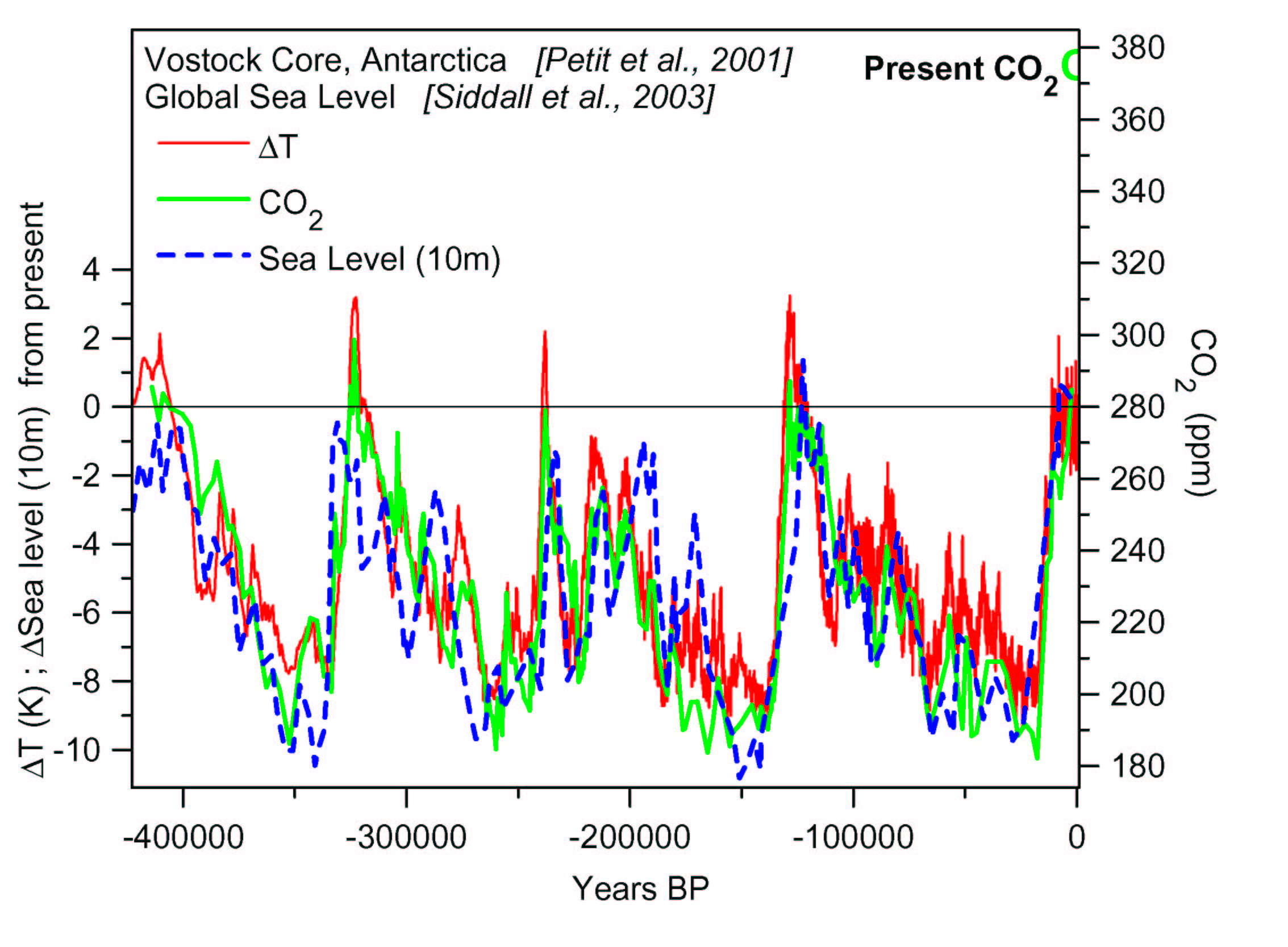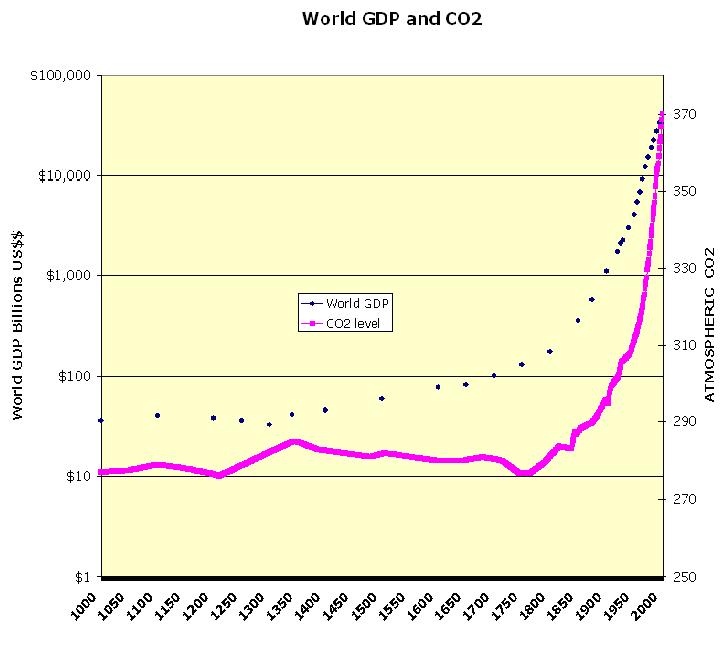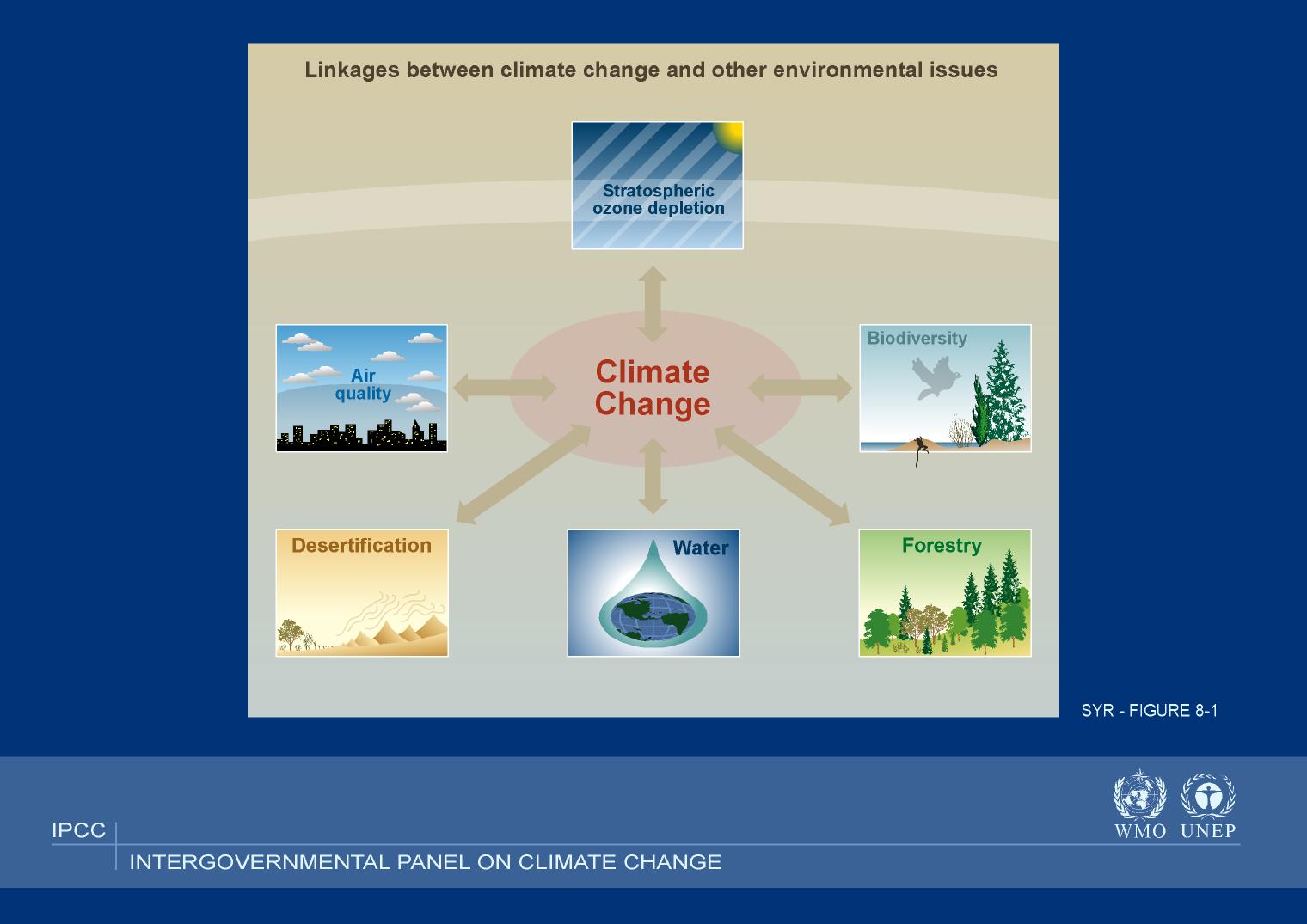Climate Change as a Sustainable Scale Problem

How is the Climate Issue Framed in terms of Sustainable Scale?
Sustainable scale in general is about a level of material and energy throughput in the economy that allows ecosystems to maintain their capacity to regenerate critical life support services.
In the case of climate change, sustainable scale has to do with the level of greenhouse gas emissions generated by global economic activities of various sorts that are below the level of emissions which threaten ecosystems’ capacities to continue providing critical life-support services, such as climate stability. Any higher level of emissions is unsustainable (see
Understanding Scale).
What Levels of Economically Generated Greenhouse Gas Emissions Are Sustainable? 
What we know for sure from a historical perspective is that annual human induced emissions of 54 Megatons of greenhouse gases, and atmospheric concentrations of no more than 300 ppm, were compatible with sustainable scale for climate stability.
We also know that current levels are considerably higher, and are likely to continue increasing over the coming decades.
In 1850 human induced greenhouse gas emissions were in the order of 54 Megatons (millions of tons) and increased to 6.7 Gigatons (billions of tons) (WRI) by 2000. Current human greenhouse gas emissions are therefore some 124 times greater than in 1850.
Ice core data indicate that average levels of greenhouse gas concentrations for the 6,000 years preceding the industrial revolution remained within a very narrow range, between 260 and 290 ppm. For the past 420,000 years (possibly the last 23 million years) it does not appear to have exceeded 300 ppm (green line in figure above). This span covers the entire course of human civilization, from long before the earliest agricultural settlements some 10,000 years ago, to the beginnings of modern cities and transportation infrastructure of the 20th century.
Today, greenhouse gas concentrations in the atmosphere are approximately 376 ppm, or some 30% above a very long baseline. (Note present level of CO2 in upper right of adjacent figure - green semicircle).
Throughput Overwhelms Regeneration: Too Much Gas
These levels of greenhouse gas emissions have exceeded the capacities of various carbon sinks to successfully absorb the gases produced by economic throughput. Sinks are renewable if the level of throughput they are absorbing remains within their absorptive capacities. If throughput exceeds this capacity, then sinks are overwhelmed and sustainable scale is exceeded. This appears to have occurred sometime in the latter half of the 19th century when global, human induced greenhouse gas emission exceeded some 54 Megatons, resulting in atmospheric concentrations over 300 ppm.
 Increased Greenhouse Gases Driven by Economic Growth
Increased Greenhouse Gases Driven by Economic Growth Levels of CO2 and other greenhouse gases increased in parallel with world GDP. World GDP increased from $359 billion to approximately $41,0000 billion (or $41 trillion) between 1850 and 2000.
Economic growth of this magnitude, in both absolute (114 times greater) and per capita terms (19 times greater), would not have been possible without the availability of cheap energy provided by fossil fuels(see
Energy).
In addition to providing unprecedented economic growth and material comforts, the combustion of fossil fuels has also created an unprecedented threat to climate stability by exceeding sustainable emissions of greenhouse gases.
What Do We Know For Sure About Sustainable Scale and Climate?
Absolute increases of greenhouse gas emissions produced an unprecedented increase in atmospheric concentrations of these gases. Greater emissions have naturally led to greater concentrations, although not in a linear fashion as human induced emissions of greenhouse gases are only a small portion of the overall carbon cycle.
Thus what we know for sure from a historical perspective is that annual human emissions of 54 Megatons of greenhouse gases, and atmospheric concentrations of no more than 300 ppm, are compatible with sustainable scale for climate stability.
Whether such levels are still compatible with sustainable scale is questionable, given that extensive deforestation over the last two centuries, and other land use patterns, has reduced the capacity of the forests and fields to sequester carbon.
As a benchmark it is interesting to note that greenhouse gas concentrations were as high as 5500 ppm some 100 million years ago, long before humans evolved. Some 34 million years ago, the concentrations were as high as 1,000 ppm, at which point there were no polar ice caps, and the planet was some 4 C degrees warmer than it is now.
What is particularly noteworthy about this information is that it is conceivable that human induced greenhouse gas emissions may produce concentrations as high as 1,000 ppm by the end of the 21st century. While we do not know what global climate patterns were 34 million years ago, we can be sure they were quite different without the enormous influence of the polar ice caps. Without the ice caps the world’s oceans would be many meters higher than they are now. Currently several hundred million people live in coastal areas around the earth.
What a Difference a Degree Makes
These increased levels of greenhouse gases have already resulted in close to a 1 C degree increase in global temperature, and it is possible that temperature could increase by as much as 5 C degrees by the end of the current century.
Both the amount and speed of the warming are a concern. We are already seeing changes in the polar ice caps and some increase in sea levels even without a full degree change in temperature. A 4 or 5 C degree increase over just a few decades will cause major changes in global climate patterns, severely affecting all life on the planet (see
Quick Facts).
It must be emphasized that current scientific knowledge regarding climate is very basic and many unpleasant surprises are likely if such warming occurs this rapidly, stretching the capacities of many nations to meet the basic needs of their populations. And there is some evidence emerging that very rapid climate changes, over the course of a decade, are possible.1
How Are Increased Emissions and Concentrations Affecting Ecosystem Functions?
Every ecosystem on the planet is somewhat affected by greenhouse gas emissions: various atmospheric layers close to or far from the earth’s surface are differentially warmed or cooled by the concentrations of greenhouse gases; land as well as the plant and animal life on, above and beneath these surfaces, are affected by and in

surfaces,
turn affect the levels of greenhouse gas concentrations; and the oceans and other water repositories are affected as well. All living organisms are affected by various climate conditions, thrive in certain combinations of temperature, moisture, wind and sunlight, and wither and die in others. These organisms are part of local and regional ecosystems involving the exchange of wastes and nutrients with the non-living environment.
These waste and nutrient flows are regulated by various climate conditions. In turn, these local ecosystems interact with each other, forming ever larger ecosystems (called biomes) [glossary] , which in turn influence weather patterns, and over time, climate (see
Biodiversity). The global climate system, in its turn, interacts with other global systems such as the atmospheric ozone layer, and the distribution of biodiversity around the planet. These intricate interconnections are one of the reasons the climate issue is so complex.
Which Ecosystem Functions Are Critical Life Support Services?
Critical ecosystem services are ones that are important for well-being, which can not be replaced by a substitute, and which can not be recovered if lost (see
Critical Natural Capital). The UV-B protection provided by the ozone layer in the upper atmosphere is one obvious example. The recycling of wastes and nutrients by various insects and bacteria are another.
Unfortunately we do not have a comprehensive catalogue of such critical life support services, either for human well-being, or the well-being of other species. As with the atmospheric ozone layer (
Ozone), we tend to become aware of which ecosystem services are critical only after they are challenged and begin reducing the level of service they usually provide.
Not only are we ignorant of which ecosystem functions are important to human well-being; we are also ignorant of which ones have no substitutes, and which ones could be irrevocably lost by higher levels of greenhouse gas emissions. The issue of substitutability or non-substitutability of various ecosystem functions is hotly debated,2 and is a political as well as scientific issue.
The even more vital issue of irrevocable loss is even less well understood. We have little solid information about what levels of material and energy throughput will trigger irrevocable losses; but at a theoretical level we can be certain that such levels exist. In short, we do not have answers to the vital questions of what levels of greenhouse gas emissions are sustainable for various critical ecosystem functions, or what levels would trigger irrevocable losses of critical functions.
Yet we do know with some certainty that such levels exist and that the more greenhouse gases we emit, the closer we come to them. Our situation is a bit like driving down a road blindfolded, where we know there is a dangerous precipice ahead, but we nonetheless continue to accelerate (see
Scale Categories).
Are Other Levels of Greenhouse Gas Emissions Sustainable?
In reality, we don’t know enough about the dynamics of global climate systems to answer this question. If, for example, 300 or 350 ppm defines the highest throughput limit of sustainable scale (see
Maximum Sustainable Scale in
Sustainable Scale), then anything over this amount degrades ecosystems’ abilities to regenerate absorptive capacities for greenhouse gases. The result is that these gases build up in the atmosphere over time and impact climate stability.
Unchecked, the
resilience (see
Panarchy) of global climate systems to absorb greenhouse gases will steadily decline. As this continues there will be considerable climate disruption and many climate “surprises,” most of which are likely to be very unpleasant from the perspective of human well-being. The safest policy goal would be to ensure human induced emissions remain within a range we know to be sustainable.
References
1http://www.whoi.edu/home/about/whatsnew_abruptclimate.html
2refs?